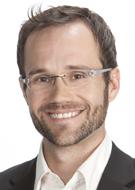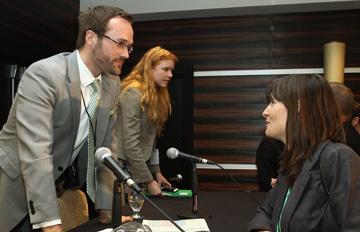At the Downtown Los Angeles VerdeXchange 2014 Conference, a panel titled “Clean Cities: Initiating and Funding Programs that Drive Sustainable Policies and Procurement” covered ways that cities can encourage industries to move toward sustainability, through partnerships with utilities and energy companies. Speakers addressed strategies cities can employ to continue facilitating technological advances and innovation. TPR has transcribed an excerpt from the panel, featuring Colin Tetreault, Former Senior Policy Advisor of Sustainability to Mayor Stanton at the City of Phoenix, and Robyn Beavers, a Senior Vice President at NRG Energy.

Robyn Beavers
"Look at water, power, agriculture, and even thermal infrastructure not as mutually exclusive systems, but as integrated things. They can balance each other and interplay in a neat way that can help reduce waste and provide some cost efficiencies." —Robyn Beavers
 Colin Tetreault: Regarding investment in sustainability, Arizona is actually in a better place than when we were going into the 2008 recession. The state of play with regard to capital and investment in sustainability projects is on the uptick.
Colin Tetreault: Regarding investment in sustainability, Arizona is actually in a better place than when we were going into the 2008 recession. The state of play with regard to capital and investment in sustainability projects is on the uptick.
I still think there’s a significant way to go, in particular in the Phoenix area. There have been some really interesting projects with investment from the federal government, private industries, and by the city currently. These are starting to catalyze a pretty big long-term shift. They actually establish continuity and certainty in our marketplace. I don’t think that existed in the 2007-2008 time period. Phoenix had all but evaporated from a capital development perspective. We’re starting to recover and the projects are starting to move forward. It’s very exciting.
Fundamentally, I think capital follows one thing, and that is certainty in the marketplace. If you have an uncertain marketplace, then businesses, organizations, and investors will simply not invest. In the fall of 2013, Arizona undertook an interesting conversation in regard to decoupling and net metering. Now that that has transpired, I think there’s a greater degree of certainty. Prior to that, there was uncertainty, from a rooftop-distributed-generation perspective as a singular example. We launched a program in May of 2012 called Solar Phoenix 2. At the time, it was the nation’s largest public-private partnership. (It was technically 100 percent private, but we utilized the leverage of the city in order to broadcast that.) There was a $25 million investment from National Bank of Arizona and JP Morgan. After that, those organizations looked at the marketplace writ large. Given the uncertainty and unknowns, they decided to stay their investment for the time being.
Now that some things particular to Arizona have transpired, certainty is coming back. That’s absolutely imperative. The City of Phoenix, as an entity, is the second-largest power consumer in the entire state of Arizona. $75 million per annum of taxpayer dollars is used on electricity. That is second only to the Central Arizona Project Canal, which pumps water from the Colorado River about 350 miles through the state. If the city as an entity decides to move down a trajectory, that itself can provide certainty in the marketplace. It’s an organizational behemoth. They could decide, from a policy perspective, to say, “We are all in on this. Perhaps we want to embrace a lower carbon economy. Perhaps we want to change our rate structure. Perhaps we want to simply pay less in the future, because this is taxpayer money we’re talking about.” That level of certainty allows the private sector an order to respond, and gauge their ramp up and their business models appropriately.
Robyn Beavers: I live in a world of uncertainty right now. That’s the purpose of my team, which the CEO of my company wanted me to come and build. My company, NRG, is one of the largest independent power producers in the US. They build, develop, own, and operate large-scale power infrastructure all around the country. We also have a retail business in deregulated markets, in Texas and in the Northeast. Those businesses used to be sure things for a long time, and NRG was really good at that sure thing. Now, the writing’s on the wall that there is a world of uncertainty ahead of us for a lot of reasons, and we need to be ready to roll with the punches.
 For instance, a lot of people in my organization, especially here in California, are really good at responding to funding opportunities for new, big generation projects, or working within the system. My team spends more of its time not prioritizing itself around existing funding opportunities or regulation. We’re trying to think about what customers want, what kind of market can help, and what technologies and products can fit in that market for those customers.
For instance, a lot of people in my organization, especially here in California, are really good at responding to funding opportunities for new, big generation projects, or working within the system. My team spends more of its time not prioritizing itself around existing funding opportunities or regulation. We’re trying to think about what customers want, what kind of market can help, and what technologies and products can fit in that market for those customers.
If instead you’re thinking, “What’s this big, audacious goal to overhaul infrastructure?” that takes a long time and a lot of money. What if you think about it from an incremental, small perspective? It might not need to take that much time nor that much money, and it’s able to scale quickly because people want it. The barrier to that is mostly a general shift in perception about how utilities or these kinds of services are provided to you, how you pay for them, and who’s offering them. The barriers are more policy, as opposed to the lack of money, I would say. I’m not really worried about the money part because if it’s a product that someone wants, that money will come.
Colin Tetreault: There’s an old joke about New Yorkers not liking two things: They don’t like change, and they don’t like the way things are. I actually think three things catalyze change: Knowledge, plus tools, plus a motivating factor equal lasting change. Broadly speaking, I think we all have the knowledge that embracing a lower carbon economy, as an example, is a smart and prudent thing to do. Do we have the knowledge with which to do that? I would say “yes”—from the private-industry sector, from non-profits, from the public sector, and from academia. The host of players are there.
What are the motivating factors for those special elements? I fundamentally believe that transparency—having civil and prudent discourse in a very open and transparent manner, especially about these things—is key. Fundamentally, you have to have the certainty and the policy vision. If that doesn’t happen, change just won’t happen.
The City of Phoenix launched a program called Reimagine Phoenix. It’s the largest systemic change ever in the history of the city or state in regard to waste management. I don’t like to use the word “waste”—I actually view it as a resource. We could fill Dodgers Stadium 14 times every year with the amount of waste just the City of Phoenix—that’s not including the 27 surrounding municipalities—sticks in a hole every year. That’s a whole lot of lost resource, opportunity, and value.
The city simply saying “we should do a thing” isn’t going to cutit. We embarked upon actually shifting that entire conversation, from changing our policies, to creating a $2 million investment with public-private funds and Arizona State University to launch what we’re calling the Center for Resource Intelligence. That’s going to do two things only with “waste” and resources: It’s going to turn your stuff into stuff, and your stuff into energy.
We’re trying to provide certainty in the marketplace regarding where we’re going. We have the knowledge, we have the tools—there are a whole lot of smart people out there—and we’re attempting to provide that motivating factor to the marketplace. That motivating factor is that we’re going to help carry that burden. We’re going to put that yolk on our shoulders and help move it forward, providing a very open and transparent opportunity for the private sector, predominately, in order to play a part in that.
The city of Edmonton, up north—our good friends from Canada—had this strategic vision of planning, as well. They didn’t say on a point-by-point, compartmentalized, or disparate basis, “We need to deal with singular waste streams, now we have to deal with recycling, now we’ve got to deal with paper, and now we’ve got to deal with aluminum.” They set a large, audacious goal. What is the outcome? They essentially went with the RFP and said, “Here is the system goal—the future scenario that mustbe achieved.” Broadly speaking to the private sector, they asked, “Do you have expertise, capacity, bandwidth, and a model to bring us to this? If you do, give us your ideas. Let’s noodle on them and find a collaboration.”
I think cities are starting to rapidly embrace that. It not only makes sense from a private-sector perspective, in order to bolster a future economy, but it also lessens the impact and long term liabilities of a city that come from having to provide services. For the City of Phoenix, it’s a municipalized waste service from a residential perspective. We’re prohibited from handling commercial or industrial accounts.
The City of Phoenix as an entity drives 7 million miles per year on a solid-waste fleet. The moon is about 250 thousand miles away from this current point on Earth. Every year, we drive to the moon and back a whole lot. It’s not necessarily a prudent thing. If we can set a large goal like Edmonton has done, along with a lot of other west-coast cities, it not only sparks private capital investment and job creation but also lessens the long-term burden from a city perspective. It frees up those capital funds to invest and leverage around other problems.
Robyn Beavers: The perspective I take is that it’s not just about how to lay out the perfect plan to make something happen. It’s more of a push. It’s about how you catalyze development and innovation around technology to provide real options. I almost feel it’s better if the government or public sector is catching up to try to accommodate that exciting new growth. If the private sector is working hard to provide real, meaningful solutions, and then the public sector is willing to react quickly and evolve with it, there’s a lot of neat stuff. It can be confusing at times, but I think stuff happens faster. At the end of the day, the value that’s provided to the customers or the public sector—or even the private sector that’s trying to speed things up around the innovation side—is really critical.
If you think about large-scale infrastructure for power, water, and waste, we’re at a point where we’re having to rebuild a lot of it. We electrified the US. We built it over the last hundred years. Now, that infrastructure is old and aging. That first approach might not be relevant anymore because it’s a little out of date. Instead of being a problem, it’s an opportunity that’s a little hard because you could go at it a lot of different ways. It’s going to involve a big shift in thinking. VerdeXchange is always a great place to come talk about this because everyone is tackling it from different angles.
Again, I’m not really worried about money, because I think it’s about the model around it. The distributed solar was able to organize and scale because that PPA model finally got a little bit mainstream. People figured it out and were efficient at organizing tax equity funds. It’s not a technology business anymore—it’s an allocation of capital business that took a little bit of time to get going. I think there are new models like that, which could emerge to help finance different types of infrastructure. The trend continues of people recognizing that waste is not mutually exclusive from water, which is not mutually exclusive from energy. They are starting to design A) from the technology and solutions side, an integrated approach to that, but B) from the financial and even the private capital side, as well as the public capital side
We need more talent in the field to be thinking about it, and we need a little bit more risk taking, because there could potentially be a really big payoff here that might not have necessarily been around before.
Colin Tetreault: If we just talk from an energy perspective, let’s go all the way back to our good buddies Nixon and Carter, from a federal perspective. We had oil and energy crises. Has anything happened to a major, systemic, large extent on a federal basis since then?
I would argue that we have not seen a major, systemic shift. That leaves the onus on cities. Cities represent an unparalleled opportunity, given their governance model.
It’s the cash, the capital, and the public sector needing to change. From the first perspective, it’s an issue of nomenclature, definitions, and conversation. Cities and businesses talk about “long-term strategic energy paradigm shifts.” What does that mean to a voter, to the standard individual out there on the street, to any stakeholder or constituent? It doesn’t register. We have to change that conversation. We have to work across those platforms.
I really admire Robyn and her work at NRG. She is working across platforms in order to drive innovation and disruption. I think that’s actually incredibly healthy. She’s also changing the conversation internal even to NRG. I think that conversation has to change—the basic words that we use—from cities, to our stakeholders, to our citizens, to our private sector.
The second aspect I’m going to talk about is redefining risk. I think cities and governments overall need to be purposeful, need to be thoughtful, and need to be considerate. Does that mean they need to be recalcitrant? No. That definition of risk needs to change. Cities are purposeful and thoughtful. They are stewards of the public good.
But how do we change that risk conversation from a basic financing perspective? As we calculate that risk, to come down in the City of Phoenix to the Office of Budget and Management, how do we make that purposeful decision? I will give the city credit on the management side. My hat is off to all of my amazing colleagues in leadership. Phoenix maintained a AAA bond rating at the height of the downturn—the only Top 10 city to do so. It was incredible. It is a testament to their financial aptitude and perspicacity. That being said, how do we embrace risk? How do we not see it as a liability, but rather an opportunity? I think we have a lot of room to change there.
Robyn Beavers: My broad-sweeping recommendation would be to look at water, power, agriculture, and even thermal infrastructure not as mutually exclusive systems, but as integrated things. They can balance each other and interplay in a neat way that can help reduce waste and provide some cost efficiencies. We need to use a different lens for the existing built environment than is conventionally used, so that all of these aren’t liabilities. If you think about them in a little bit of a different way, they can be actually quite exciting.
For instance, while I might have a CEO who wants to eliminate the polls and wires for the electric grid completely, I actually don’t want them to go away. Instead of this one-way supply that everyone’s really dependent on, it can become eventually a marketplace for multi-directional flow of electrons, which people are generating locally and maybe selling elsewhere. Or, it’s balancing it for the overall good of the system, so that existing infrastructure becomes more valuable to us again and more exciting without even having to build anything. It’s just about the market framework you put around it.
Those poles are good real estate. The cable industry figured that out, too—they pay a lot of money for square footage on those polls. The same thing could be said for aqueducts. That’s a lot of space that could be used in interesting ways, and maybe even lead to benefits of prevented evaporation or collocation with the pumping stations. Thinking about distributed renewables around that infrastructure is pretty exciting. Again, my recommendation would be to learn about how these things interplay, and then think about how you can transform existing infrastructure into new opportunities for values and performance.
Colin Tetraeault: LA is an exquisite area in terms of social heterogeneity. That needs to be represented in the ranks, not just from a gender perspective, but also from an ethnicity perspective. To quote Virgil, “Fortune favors the bold.” From a policy perspective, I think you need to have some bookends. Don’t be bashful. Be bold. You need to push the needle on these things.
From a business perspective, if you push hard, there’s always room to come back. But if you acquiesce and get only a small movement, it’s going to be more difficult to get incremental change. You need to be bold. You need to provide certainty. You need to embrace a much younger and a much more vibrant demographic, as well.
- Log in to post comments



